Blog, Fermented Food, Homebrew Recipes, Recipe Box
Honeysuckle Wine: One Gallon Recipe
Amber Shehan • April 20, 2016
Honeysuckle is an invasive plant with some of the most lovely, ephemeral flowers - their heavenly aroma lends itself nicely to this wine.
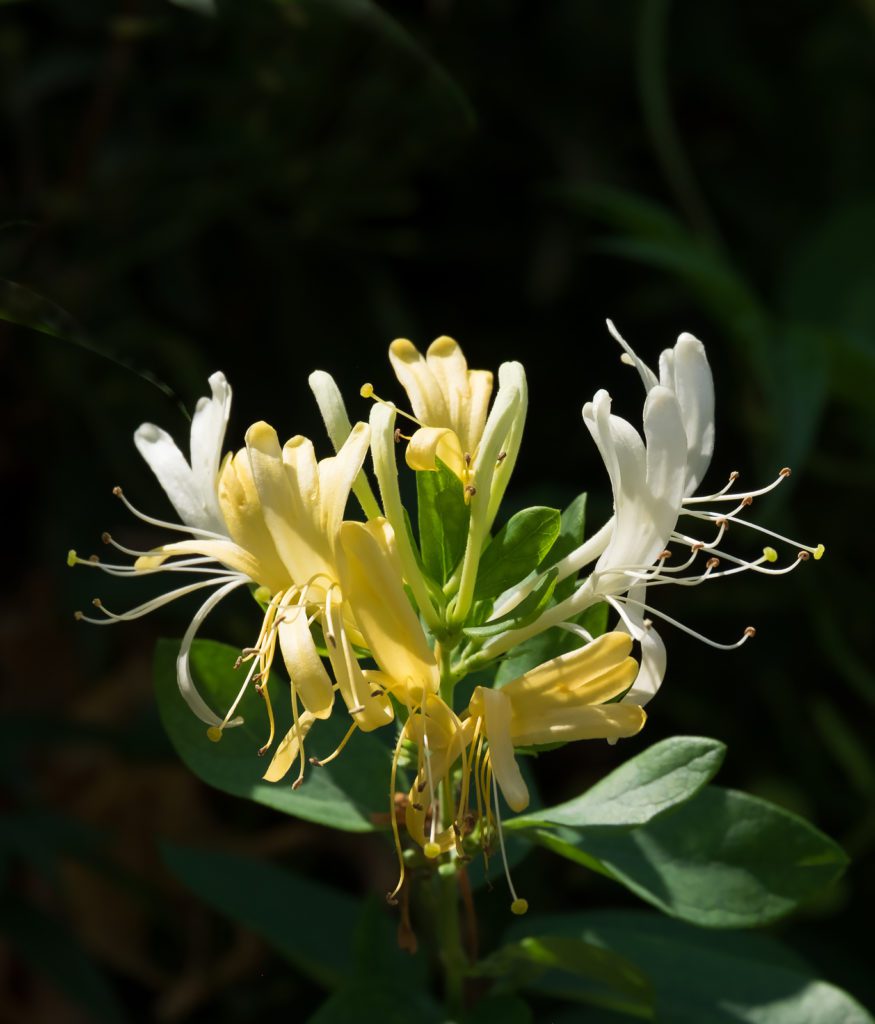
Honeysuckle has been one of my favorite flower friends since I was but a wee pixie. There was a special bush, an old-growth clump of honeysuckle that grew tall and then draped over towards the ground like a willow or a weeping cherry. It was a magical place in the corner of my grandparents’ suburban yard where I could go and hide from the bright sun, gaze up at the blue sky through the green and white haze of leaves and flowers, and listen to the low, slow buzzing of the other species who supped from flowers as I did.
Sticky-fingered and sunburned, I’d retreat indoors later in the afternoon like a besotted bee drowsing back to the hive at the end of the day.
Now that I have my own lawn to tend, I am somewhat concerned about the amount of honeysuckle that I see. This lovely plant grows very quickly and overtakes everything it touches, rather like kudzu. Therefore, I am unashamed at how many honeysuckle flowers I harvest. Whenever I have anger bubbling up inside, I’ll take it out on the ever-encroaching wave of green vines that surround my little yard, cutting the young trees free from its grasping clutches.
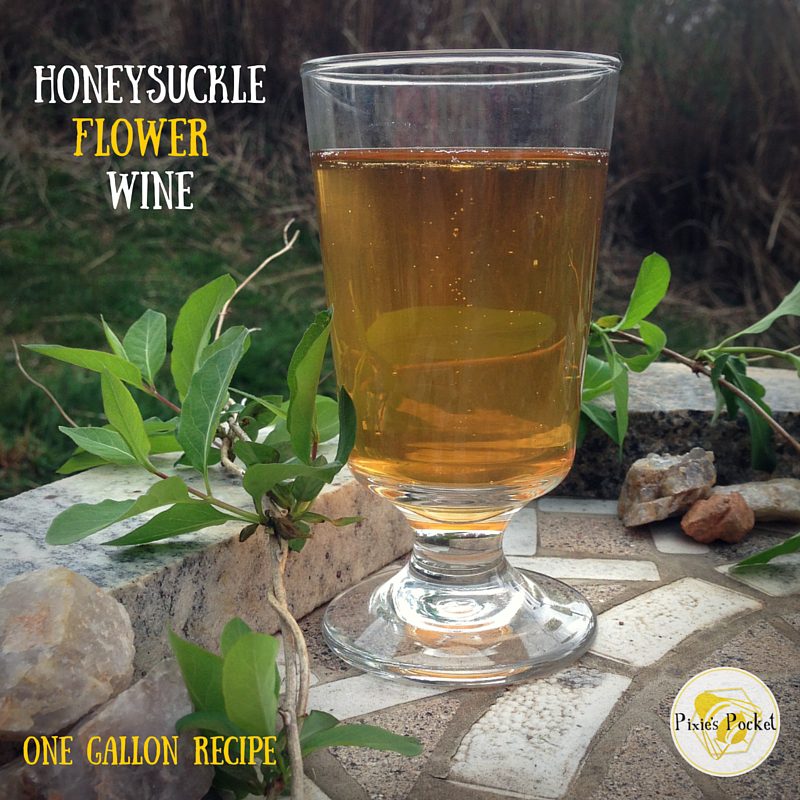
Honeysuckle Wine – 1 Gallon Recipe
Ingredients
- 1 gallon of water (filtered is best)
- 4 cups of sugar
- 6 cups of honeysuckle flowers with the green tips removed
- 1/4 cup of raisins (golden are best)
- 1 bag of black tea (green or white tea is nice, too.)
- 1/2 packet of yeast (I like Lalvin D-47)
How to make Honeysuckle Wine
Harvest honeysuckle flowers! This is the fun part. You’ll need six cups of flowers for this recipe. Watch for buggies, don’t forget to wear sunscreen, and expect the neighbors to slow down and look at you quizzically as you forage.
As the sweet pollen nestled into the white velvet flower cones is so delicate, I prefer to go without rinsing the flowers before using them. Before you get grossed out by the idea of dirt or buggies, don’t worry – we’ll make sure the result is bug-free.
Process the flowers by chopping off the green bits (sepal) and putting the flowers in a gallon pot. Add the raisins to the same pot.
Grab another large pot and add about 2/3 of a gallon of water. Add the teabag. Allow it to come to a boil.
When the water is at a steady, rolling boil, remove it from the heat and remove the tea bag. Add the sugar. Stir it carefully until it is all dissolved.
Pour the hot syrup water over the flowers and raisins in the other pot, put a lid on, and let it steep for at least an hour.
While it is steeping, sanitize your gallon carboy, airlocks, bungs, and funnel with a store-bought sanitizer.
Once the honeysuckle must has steeped and cooled down a bit, set the funnel in the neck of the carboy and set a strainer inside the funnel to catch the flowers (and bugs!). I use a funnel with a built-in strainer. Pour your delicious honeysuckle nectar into the carboy. Add more clean, filtered water until the must is up to the neck of the carboy. Add in the bung and the airlock to keep everything clean.
Allow the must to cool down to body temperature before you pitch your yeast – since it is a small, one-gallon batch, add about a teaspoon of yeast.
Racking, Backsweetening, Bottling
After a month or two, the fermentation will slow to one wee bubble every 30 seconds. At that point, I taste the brew to see how it suits me. If it needs more sweetness, I’ll rack the brew over to a new carboy and add some sugar or honey syrup to get it where I want it. If you add sugar, let the wine sit for another day or two until you’re sure it hasn’t restarted fermentation. Next, bottle!
Tasting Notes
Everyone who tried my honeysuckle wine thought that it was mead! The delicate flavor and aroma of honeysuckle remain present and pleasing to the palate, even after a bit of aging. I hope that you try and enjoy this wine…well worth the sunny day spent harvesting flowers!
Need more help, tips, and a free guide to brewing one-gallon batches of wine and mead? Here you go! You can also pick up a copy of my book:

Get updates from Pixie's Pocket: brewing and herbs in your inbox:
Posted In Blog, Fermented Food, Homebrew Recipes, Recipe Box
Tagged: brewing, eat your weeds, featured, homebrew, honeysuckle, invasive, one gallon, recipe, recipe box, recipes, sugar, wine
Amber Shehan
Hi! I'm Amber Pixie, and this is my site. Enjoy the recipes, information, posts, and please feel free to message me if you have questions!
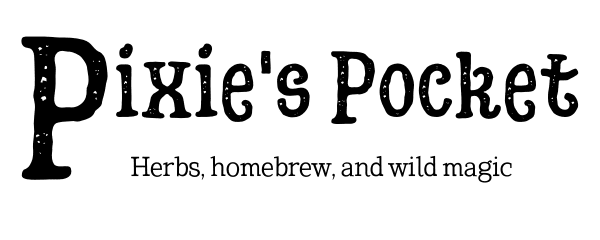

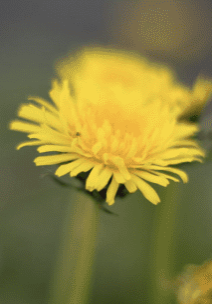
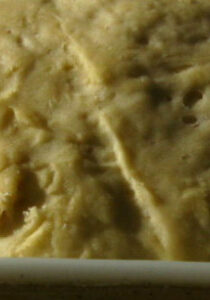
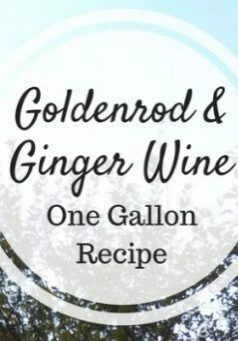
When do we add the raisons? or do you just eat them while working? 🙂
Yipes! Good catch! 🙂 The raisins go in with the flowers, just as you pour the hot syrup water over them. Thanks for that, I’ll update the post to include that detail!
Hi I was wondering when the tea bag came into the recipe I don’t believe it was listed
Hello! Sorry about that! I add the tea bag when the water goes on to boil, and I remove and strain the tea bag before I add the sugar. I fixed the recipe, thanks for pointing that out!åç
Oh, and by the way, your leatherwork is BEAUTIFUL! 🙂 I’m a Rennie and Faerie festival attendee/volunteer/vendor myself, partly because of artisans like yourself.
Any ideas about the ABV?
Thank you for the compliments! You make me blush! My wife and I are Rennie’s ourselves. We have started the honeysuckle wine without the raisons. It is bubbling away. We will let you know what happens without the raisons.
Don’t worry, I’ve brewed many times without the raisins and it’ll work just fine. THey just help add some body and nutrition for the yeast. 🙂
what flowers do i pick just the white ones or any of them at different stages?
Hey Don! I tend to pick the white ones mostly, but there’s a few yellow ones thrown in, too. Just avoid actively wilted ones that are going brown, that wilted flavor translates into the brew!
ok thanks im planning on making some wednesday
My honeysuckle adventures involved getting to the flowers before the bees did and sucking the nectar out for myself. Even as an adult I can hardly resist. Unfortunately where I live now has no honeysuckle vines which is just as well as my son would root them out as quick as possible.
I don’t think I could root out all the honeysuckle on my property, but I do try to use as much as I can and trim it back every year. 🙂
Thanks for the awsome recipe! I can’t wait to try it.
Hi, I just started my first batch of honeysuckle wine today. I just wanted to give you a little tip. I teach brewing and have been making all sorts of fermented foods and beverages for a few years now. You should never backsweeten with sugar, simply because it will restart the fermentation. You might only get a sparkling wine with that, or you might get a bottle bomb which you don’t want. Backsweeten with something non-fermentable, like stevia or xylitol. I’ve used both successfully, however the amount of sweetness that’s left after fermentation depends upon the yeast that’s used. 🙂
Thanks for the tip! I’ve considered using xylitol, but I can’t stand the taste of stevia…mostly, I do end up with sparkling batches but I’ve yet to have a bottle bomb after all these years! I do open my grolsch bottles outdoors, though, just in case there’s a foamy blast. 🙂
[…] Regardless of its classification as a “noxious weed” throughout much of the northeast and parts of the southeast, honeysuckle is still hailed by many as a classic and nostalgic scent. It is purposefully placed as a barrier for erosion control and for its aesthetic appeal. It is the focus of several perfumes and has made appearances as an ingredient in wine. In some wineries throughout Virginia, wine featuring notes of honeysuckle make for a popular souvenir to bring home or to experience during a tasting. At the Native-American Mattaponi Winery in Virginia’s Spotsylvania County, their “Golden Horseshoe” wine has a strong presence of honeysuckle. In other parts of the South and all across America, honeysuckle wine is sold as a sweet, familiar commodity. If you’re lucky enough to have heaps of it growing in your backyard, you can make your own honeysuckle wine! […]
I’ve used your recipe for the last two years and my family loves it. Thanks for posting it.
Thank you, Curt! I’m glad you all enjoy it! I’m eyeing my fencerow of honeysuckle hungrily – I can’t wait to make some more this year. 🙂
Amber, this is wonderful! The honeysuckle at home is in full bloom right now, perfuming the air delightfully, so I am really excited to give this a shot. Do you have any recommendations for anyone who doesn’t have the needed gear? We could probably scrounge up a 1 gallon jug but we don’t have a bung… I could get a kit from Amazon but I’m trying to be mindful of ordering non-essentials during the pandemic. I have fermented foods before but never made wine. Since yeast is involved I assume airflow is important. Could a well covered open top with some cotton fabric covering it work?
I’m SO SORRY to have missed this – I wasn’t getting notifications about people commenting!
In my experience, using the cotton fabric isn’t sufficient – wild yeasts and other minuscule bacteria can still get in, which can cause vinegar or other unpleasant results.
If you have a homebrew shop near you, a bung and airlock are super cheap! Amazon isn’t bad and they are still able to ship those things – also check out Great Fermentations (a homebrew shop online). You can also find bungs at some home supply stores on the doo-dads aisle. 🙂
Hello! I started a batch last night around 9pm. This is my first time trying to ferment wine. It’s not bubbling yet, should I worry? Add more yeast? It’s currently noon here.
Hi Leah! If it isn’t showing any action by now (a day later!) then yes, add more yeast! How’s it doing?
Good morning! I’m making the blueberry muffin mead from your book but all I have on hand is the K1-V1116 yeast. Could I use that in place of the D-47 or would it totally alter the recipe? I’m new to wine making and this would be my first mead. I wanted to start a special one for my husband for Father’s Day.
That should be fine! The K1-V116 yeast will accentuate the floral and fruit flavors and is quite nice for melomels (meads with fruit), so brew away! 🙂 Cheers, Kate!
Hi! I want to try this wine, but I would like it sweet from the get go, and not to add sugar. How much sugar should I use if thats the case? Thanks!
HI, how soon can we drink the wine after bottling? Starting a batch today.x
It varies depending on temperature and so many factors, so I just bottle once it is clear and there are no more bubbles at all. You can drink it then but the longer it ages in the bottle the better it gets!
How packed are the flowers per cup? loose or crammed?
Loosely crammed? It’s full but not squashed if that makes sense. I don’t want to crush the flowers and make them smell witty!
Hi I hope you see this comment or rather a question. Do you think that you could use dried honeysuckle with this wine? I have no access to a honeysuckle bush but I know I can find people who dry organic honeysuckle. Thank you for any info. I used dried flowers for my dandelion and it is brewing right now and looks great.
Hello! In the ingredients section you have a bag of black tea listed. I don’t see it mentioned again when it comes to the process of making the honeysuckle wine. I was wondering if you step it with the boiling water or if you add it with the fermentation in the carboy?
Hello! Sorry about that! I add the tea bag when the water goes on to boil, and I remove and strain the tea bag before I add the sugar. I fixed the recipe, thanks for pointing that out!åç